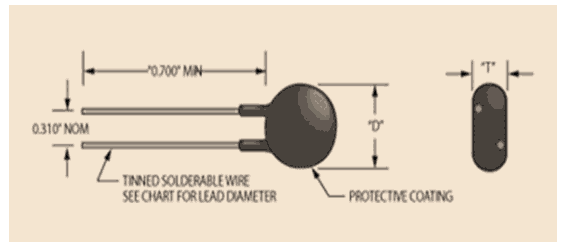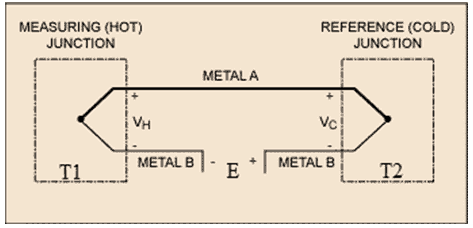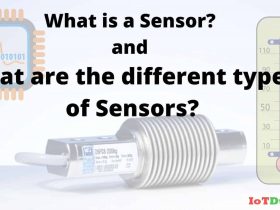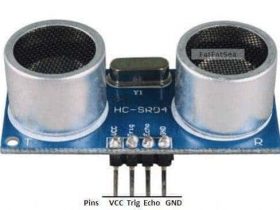Temperature Sensors
- Temperature of a substance is a measure of Heat (hotness or coldness) inside that substance. It is the prime factor in industries like pharmaceutical, heavy plant, sugar industries, etc.
- Temperature decides final product behaviour in most of the cases.
- Here we are going to discuss all different types of temperature sensors used in Industry for Industrial IoT (IIoT) project development.
- Following industrial temperature sensors are also used in college labs for performing any temperature-related experiments and research work.
Basically there are two types of temperature sensors
- A) Contact Type:
- B) Non-Contact Type:


Figure 1: Types Of Temperature Sensors
A. Contact Type
In contact type , temperature sensor differentiate based on two different method
-
Electrical Method
a) RTD
b)Thermistor
c) Thermocouple
2. Non-Electrical Method
Electrical Method is most widely used in Industry for Industrial IoT application development.
Non-Electrical Method is not applicable for IoT application development.
See also: How is IoT optimizing Costs for Industrial Sectors?
So, here we will discuss only Electrical method Temperature sensors.
Electrical Method
This method is mostly used on Industrial level as output is in electrical form. It can be transmitted to long distances and it can be further amplified as per requirement.
1) Resistance Temperature detector (RTD)
As the temperature of conductor changes according to that resistance also changes. This principle is used to measure temperature of material.
By supplying constant current to the RTD measuring voltage drop across resistor, we can calculate RTD resistance and from that temperature can be determined.


Figure 2: Resistance Temperature Detector
Image credit: correge
The material used for construction is selected such that change in resistance (R2-R1) of material per unit change in temperature (T2-T1) should be as large as possible, it should have high value of resistivity, temperature and resistance of material should be in continuous and stable relation.


Figure 3: Resistivity Chart for Different Metals
Output type: Temperature in degree Celsius (°C) .
Measurement Range: -200°C to 650°C
Advantages:
- Accuracy of measurement is good.
- Wide Range of temperature which is in between 200°C to 650°C.
- Response time is low.
- Reproducibility is good.
Disadvantages:
- Need bridge circuit and power supply.
- Can be affected by mechanical vibrations.
- Bulb size is larger than thermocouple.
Applications:
- Petrochemical Process Industries
- Plastic Process Industries
- Air, Gas, Liquid temperature measurement
- Air Conditioning and Refrigeration system servicing
- Exhausting gas temperature measurement.
2) Thermistor
- They are semiconductors combination of pure oxide of nickel, manganese, copper, cobalt, iron, manganese, titanium and other metals sintered at temperature over 980°C in order to display large changes in resistance in proportion to small changes in temperature.
- The material used in thermistor is ceramic or polymer or combination while RTD uses pure metal.
- Generally Negative Temperature Coefficient (NTC) thermistor is used in application.
- A very high Negative Temperature Coefficient allows circuit to detect very small change in temperature.
- An NTC thermistor has a non-linear response to temperature. We can determine the resistance of a thermistor by measuring the voltage across it in a potential divider circuit. Then, we can get a resistance from this by using Ohm’s law.
- Relation between resistance and temperature.
- R(at temp T1) =R(at temp T2) exp[(1/T1 – 1/T2)]
- R(at temp T1) =Resistance of thermistor at Absolute Temperature T1°K.
- R(at temp T2)= Resistance of thermistor at Absolute Temperature T2°K.


Figure 4: Thermistor
Image credit: usesensor
Output Type: Temperature in °C(degree celsius) or °K(degree kelvin).
Measurement Range: -100°C to 300°C
Advantages:
- Small unit.
- Response time is low.
- Cost is low.
- Higher sensitivity.
Disadvantages:
- Temperature Vs Resistance is non linear.
- Limited temperature range.
- Stability is less at higher temperature.
Application:
- Industrial Process control, emission control and differential temperature control.
- Monitoring and controlling engine temperature.
- In fire protection and safety system.
- Copy machines and industrial soldering iron.
Manufacturer:
Sellers:
3) Thermocouple
It is based on Seebeck Effect.
Seebeck Effect: If two dissimilar metals are joined together so as to form a close circuit there will be two junctions where they will meet each other. If one of these junctions is heated, current flows in the circuit which can be detected by galvanometer. The amount of current produced depends on difference in temperature between two junctions and on characteristics of two metals.


Figure 5: Seebeck Effect
Image credit: Maxim Integrated
Let, the junctions are kept at absolute temperature T1,T2.
∆θ=T1 – T2
Thermal EMF developed is given by,
E(VOut)=a(T1-T2) + b(T1-T2)2
Where, a & b are constants which depends on material used.
E ( VOut )= a(∆θ) + b(∆θ)2
a>>b
E= a. ∆θ
Figure 6: Thermocouple
Image credit: Analog
Laws Of Thermocouple
Law 1: The emf of thermocouple depends only on temperature of junction and independent of wires connecting junction.
Law 2:If the Third metal C is introduced into A or B then provided the two new junction are at same type (T3) & emf is unchanged.
Law 3: This law makes it possible to use extension wires of a metal different from the metal used for thermocouple.
- The extension wire used for Platinum/Platinum Rhodium thermocouple may may be made of copper which is an inexpensive material.
This law makes it possible to enable measuring instrument to be introduced into the circuit without affecting the emf generated by thermocouple.
Wires forming the junction can be soldered or brazed together without altering performances of junction.
Law 4: It is used while making correction to the thermocouple readings in case of cold (Reference) junction temperature is different from one for which thermocouple is calibrated.
The calibration curve and charts are available for reference junction temperature at 0°c. In case temperature of reference junction is different from 0°c the calibration curve no longer hold good and correction have to be applied.
If thermocouple calibrated with reference temperature 0°c is used with this junction at 20°c the thermocouple will read correctly if emf lost due to reference junction being at 20°c is added to measured value. The value of lost emf can be read off from the table of correction for thermocouple used.
Note: To differentiate RTD and Thermocouple as both looks same and 2-wire, Measure resistance between 2 wires and it should be 0-100 ohm then it is RTD and if it is around 5 ohm then it is thermocouple.
Difference between measuring and reference junction voltage is measured and voltmeter readings are converted into temperature.
The conversation table is supplied by thermocouple manufacturer.
Measurement of Thermocouple Output
- To determine the output voltage directly with a PMMC instrument. A milivoltmeter is used as output is in order of mV.
- Determine output voltage by D.C. Potentiometer.
- By measuring output voltage by amplifying it.
Reference Junction Compensation (Calibration)
As thermocouple are calibrated at 0°c, If thermocouple is not at 0°c the value must be corrected by adding the voltage that result from temperature difference equal to amount by which reference junction is above 0°c.
Types:
| Name | Range °c | Positive Wire | Negative Wire | Advantage |
| R type | 1700 | Pt 87 Rh 13 | Platinum | Response is Fast, Small size |
| S type | 1700 | Pt 90 Rh 10 | Platinum | Response is Fast, Small size |
| K type | 1300 | Chromel | Alumel | Linearity |
| E type | 1200 | Chromel | Constantan | High emf at 0°c |
| J type | 1000 | Iron | Constantan | Economical |
| T type | 400 | Copper | Constantan | Resistive to corrosion from Moisture. |
Figure 7: Types of Thermocouple with wire used and Range
Output Type: Temperature in °C(degree celsius).
Measurement Range: -270°C to 2800°C
Advantages:
- No need of bridge circuit.
- Range is from -270°c to 2800°c which is very wide amongst all.
- Not expensive and easy to use.
- Variety of designs available.
- Possess long transmission range.
- Low response time.
Disadvantages:
- Low accuracy
- Temperature voltage relationship is not linear.
- It needs amplifier in many applications.
- Need reference junction temperature for measurement and calibration.
Applications
- Plastic industry prefers cost effective thermocouples like J type.
- S,R,K type is generally used in steel and iron industry to monitor temperature.
- In process Plants and Refineries.
Manufacturer:
Seller:
Comparison
Sensitivity: Thermistor > RTD > Thermocouple
Linearity: RTD > Thermocouple > Thermistor
Range: Thermocouple > RTD > Thermistor
If you like above article please comment below and if I missed anything in electrical type industrial temperature sensors , please suggest me , I would like to update here.
If you like this post subscribe to our YouTube Channel for IoT video Tutorials. You can also find us on Twitter, Facebook, and Instagram for more updates.
and If you have smart product or service and looking for perfect audience then submit a guest post at IoTDunia and get to know in IoT world.















Awesome! Information. Great work thank you for sharing such useful information. keep it up all the best. I can also refer you to one of the Best Thermal sensors services in Hyderabad.